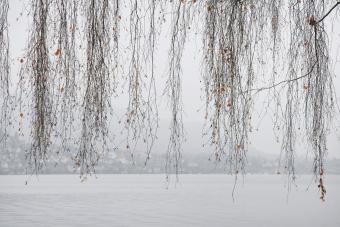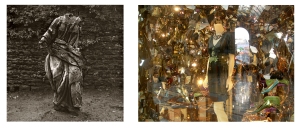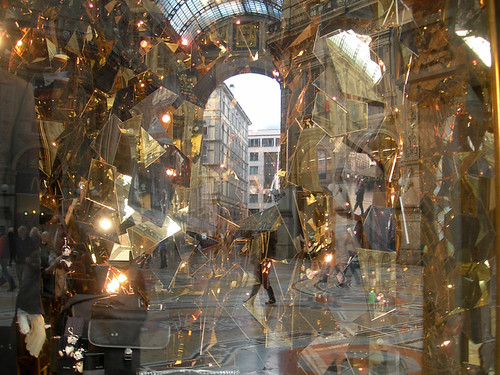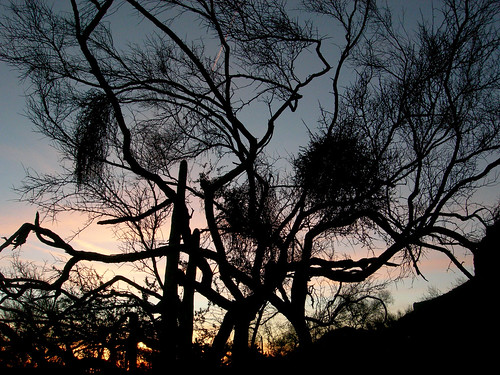The Big PhotoBook Sale
 I am raising some money for a few months of travel and working on some projects so I am selling off the bulk of my photobook collection.
here is a link to a google docs spreadsheet with a list of photographers, titles, and conditions.
I am raising some money for a few months of travel and working on some projects so I am selling off the bulk of my photobook collection.
here is a link to a google docs spreadsheet with a list of photographers, titles, and conditions.
New Work—Mojave Desert Artifacts
I just updated my website with new images from my Mojave Desert Artifacts series. I will be going back into the studio for the next few weeks, and will be uploading more as soon as I can.
Project Basho—Onward 2011 Reception
It was great to meet so many old and new friends at the opening on Saturday. I am super excited that the show is going to Tokyo in May, and congratulations to the two photographers selected to be flown to Japan to attending the opening.
There were close to 300 people who attended the opening, and there wasn't a chance to spend much time or room to really take in all the great work on display.
Here are a few of the snapshots I made that day. And a link to the Onward Blog for a list of all the winners.
New Work—Mojave Desert Artifacts
 Here is new work from my series of "artifacts" collected from an makeshift gun range in the Mojave Desert.
Here is new work from my series of "artifacts" collected from an makeshift gun range in the Mojave Desert.
I made a cross-country drive a few weeks ago, and was able to bring back crates of these collected objects to my studio near Philadelphia. In addition to photographing more of the new and much larger pieces, I will incorporate the actual objects to be shown alongside the large format platinum prints as kind of a mock-anthropological exhibition based on the culture of the desert southwest.
A large-format platinum print will be on view at Project Basho's Onward 2011 show opening today, with an opening reception on Saturday, Feb, 12. I will be there between 2:30 to 4:30, so stop by to have a chat and see some great photography by emerging artists from around the globe.
Project Basho— Onward 2011
 Mojave Desert Artifact #5, 2010
Mojave Desert Artifact #5, 2010
I am thrilled to announce that one of my new platinum prints from my Desert Artifact series was selected by Larry Fink for Onward, Project Basho's juried exhibition for emerging photographers. The opening reception is February 12, and the show runs through March 27.
Here is a video or people in Philadelphia announcing the selected photographers.
[youtube=http://www.youtube.com/watch?v=DJ8na4Dz4ME&fs=1&hl=en_US]
(1:16)
New Work— Mojave Desert Artifacts
These new photographs, 16" platinum-palladium prints made in the summer of 2010, are an extension of the aerial photographs I made of an off-highway recreation area in 2009. I am in the process of writing a more complete statement about the larger scope of the project, but for now, I will say that looking at the culture of recreation in the desert from the point of view of a future archaeologist and historian is an interesting way of exploring my own history within the context of the culture where I grew up, and, at the same time, not pass judgment of the people or the area.

New Series— Tree Stands
 Here is a glimpse of my newest series of photographs. Like most of my work lately, it revolves around the idea of recreation within the landscape, focusing on the signs, remnants, and detritus of these activities. As I explore the idea further, I am drawn more and more to the duality of the positive aspects associated with these various forms of recreation and their often violent and destructive nature, and their basis in American culture.
Here is a glimpse of my newest series of photographs. Like most of my work lately, it revolves around the idea of recreation within the landscape, focusing on the signs, remnants, and detritus of these activities. As I explore the idea further, I am drawn more and more to the duality of the positive aspects associated with these various forms of recreation and their often violent and destructive nature, and their basis in American culture.
Daniel Shea Print Sale 2010
For those who have not heard, Daniel Shea is having a fund raising print sale to help offset the cost of his new series, Plume— an extension of his work documenting the devastating coal mining practices in (Re)moving Mountains. What I have always admired about Daniel's work is his dedication to the subject, and the thoroughness in the way he approaches his projects. He brings nothing less to this series.
This new series focuses on two communities surrounded by several coal-fired power-plants. While the focus is on these two communities, the pictures, choked with the ever-present haze of summer in the Ohio Valley and power plants looming in the background of nearly every picture, stand as an symbol for the national coal-fired power industry and the critical importance of finding a suitable, sustainable, clean, and renewable replacement for coal.
Anyone who has had to find funding for a personal project knows how important even $30 can be. Whether it is a few meals, a tank of gas, or a few sheets of film (or a single sheet of film in some cases), every dollar counts. So if you have the extra cash, throw down for a print or two. If you have more, consider getting a larger limited edition print— along with knowing you are helping further the creation of important work, you will get a beautiful photograph. What is there to lose?
So much for a fresh idea
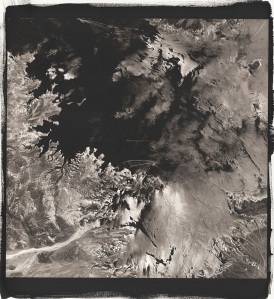 Richard BoutwellLake Mead #5, 2008 Platinum/Palladium Print
Richard BoutwellLake Mead #5, 2008 Platinum/Palladium Print
Richard Botuwell Saudi Arabia #3, 2008 Platinum/Palladium Print
I have been working on and off for the last two years compositing hundreds of appropriated satellite images to make massive files which I use as a starting point for making large-format abstract platinum-palladium prints of places of economic, political, and environmental interest. I was initially drawn by the aspects of multi-layered abstraction created by elevation and the compositing of images captured over the course of several years, and the way in which we increasingly rely on viewing satellite and aerial images in daily life—from finding our way to a restaurant on Google Maps to their use fighting wars.
I have been dreaming about how to write a grant that will allow me access to a satellite and a year to make pictures with it.
Looks like Andreas Gurksy had the same idea—sort of.
Here is an excerpt from the press release for his upcoming show at the Beverly Hills Gagosian Gallery.
In the new Ocean series, Gursky has for the first time relinquished his position behind the camera to work with satellite images of the world as his raw material, creating contemporary mappe del mondo on a scale befitting the cosmic grandeur of the subject. In their darkly nuanced surfaces, he has worked to reconcile the division between the machine eye and the human eye, continuing the debates and practices begun in the nineteenth century regarding photography and the issue of artistic expression versus objective science.
 ANDREAS GURSKY
Ocean II, 2010
Chromogenic print
ANDREAS GURSKY
Ocean II, 2010
Chromogenic print
Lightroom Winter Art Salon
Come out this Saturday evening at 6PM to the Lightroom's Winter Art Salon at Al Wachlin's house (Art Museum area) . I will be showing new platinum prints from my series of aerial photographs, as well as several photographs from my series on the Lower Owens River Project in Eastern California. It will be pretty informal and photographers are encouraged to bring there own work.
Hope to see you there.
2023 Mount Vernon St. Philadelphia, PS 19130
for more info call 215-828-1661
Photo-Review 2008 Competition Winners
I finally got a chance to look through the new issue of the Photo-Review—the edition with the 2008 competition winners. I didn't think about the printing being only greyscale until I went to the website to insert some images into this post. I realized most of the selections were originally in color. What was more interesting to me was the images I would not have given a second look as color photographs I found more interesting when presented in black and white and vice versa. Here are a few of what I think are the real gems.
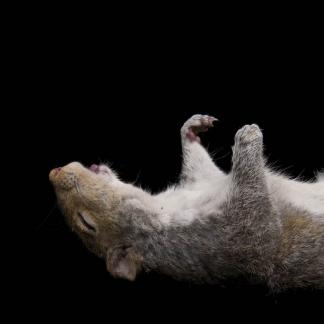
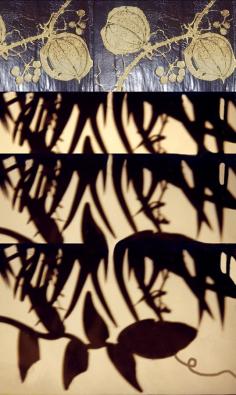
California, Venice, Spain
I needed a break from the day job so I took off for a few weeks in May. First California to continue photographing the progress of the Lower Owens River Project and then 10 days in Venice and Spain. Venice was a selfish romantic excursion and Spain was a selfish photographic one. My last day in Spain I found this great stereo-view in a Barcelona flee market. It makes me wish I had taken my stereo holga . . .
Instead I had my hand-me-down, scratched and taped-up digital point and shoot that I love to death.
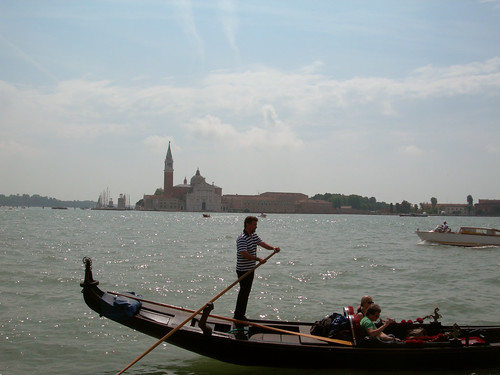
So when I got to Spain the first thing I did was rent a car and head to the coast and spent three days driving, hiking and camping along the Mediterranean north of Barcelona. Here are two from the Cap de Creus National Park.

and this one of a really brave kid in Barcelona
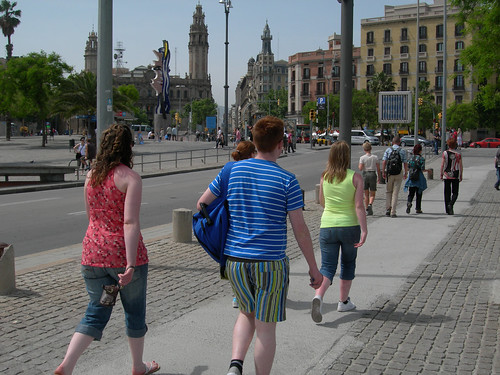
Back In It
New Year's Resolution #27: Make blog post. I sort of lost all drive for posting here these last few months. I have been working, traveling some, doing new work.
Now, with freezing weather out, I am in a place to start again with the commentary.
I (finally) have a flickr account. So for now, I will just open up the shoe box and throw up a few from the last year.
First Real Platinum Print
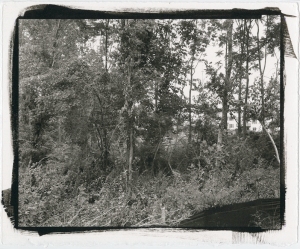 I have been learning to make platinum prints for the last few months, and this is one of the first that I am willing to call a final print
I have been learning to make platinum prints for the last few months, and this is one of the first that I am willing to call a final print
The problem I have with printing platinum is nothing I do is a straight print, and everything requires some buring or dodging for local control for the sake of balancing the print. I tried making digital burning and dodging masks printed on transparencies. But, I found that torn pieces of tracing paper and a glue stick work much better and is easier to alter as I'm printing.
UPDATE 12/12/12: You can read more about my adventures in platinum/palladium printing at my blog devoted to the subject at www.platinumprinting.wordpress.com/
New Print from the Lower Owens River Project
I finally had a chance to develop my films from my June trip out West. I even developed some other films that were sitting in a box for just over a year . . . This from my most recent trip to work on my series on the Lower Owens River Project. This was made near the culverts on the South side of Manzanar Reward Road. I have been mapping some of the images on Google Earth. Here is an image from Google Maps of what the area looked like before water was flowing. View Larger Map
4x5s everywhere
Well almost . . . When you use an 8x10 for a few years everything else just starts to feel a little small. It is like driving a dump truck all day then picking up a Tonka Toy. That being said, it is still good to be out seeing people using cameras with some umph to them. But it is funny when people talk about a Hass like it is sizable camera . . .
I was driving down Delaware Ave a few months ago, and there was a guy in the median with a 4x5, and I was like, "hell yeah! get some!" Then on Thursday I came out of Project Basho for some coffee and there was a youngish guy across the street with a 4x5. So I was surprised as hell when on Friday night at 30th St. Station, while I was waiting for the last train out of town, I saw yet another guy (maybe same guy) with a 4x5 a few platforms away. I wanted to go up to talk to him and just see what was going on, but I know how annoying it is when people come up to me while I am working asking me dumb questions about why I'm using such a big camera, or what I could possibly be photographing . . .
My best 4x5 sighting was during spring break in 2001 driving down PCH on a trip in Big Sur. She was young, blond, and standing on the retaining wall with the camera pointed down, looking into the ocean.
What is Success Really?
Amy Stein wrote in her recent post about Jill Freedman, “It's great to see an artist get her due after so many years, but it's disheartening to know you can have the goods and still fall off the art world map.” I don’t know if a show at a gallery no one has ever heard of and a Times article constitutes “getting her due.” I am certainly not saying that she is not deserving of the recognition or that I am not happy for her. It is always good to see people get the recognition they deserve (the photographers not deserving are the ones I have a problem with . . . but who am I to judge . . . ) I have to ask myself, what are the real motivations and goals of this new breed of photographers? By this new breed I mean every photographer just out of college a lot of energy and a blog? What is their idea of success? a show? sales? a book? a posting on Jorg’s blog?
For a paycheck (if you can call it that) I work for two photographers, both of whom have several books and are collected in dozens of major American and European museums. They are both represented in a few galleries (like that really means anything), and had work at AIPAD this year. They are also now in their sixties with no savings and no healthcare and are uncertain where the money is coming from after the next few months. I guess the most important thing I have learned working for them is that it is always going to be rough. And, while good things may happen—sales, shows, books—the only rational reason for being a photographer is the irrational love and necessity of making pictures. I can’t speak for everyone, but the moment, my only goal is to be able to continue making pictures.







